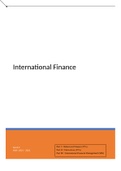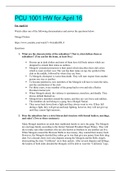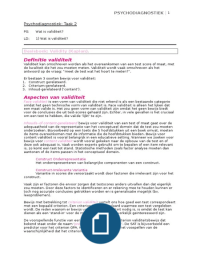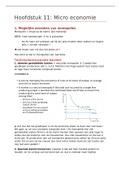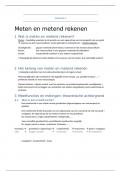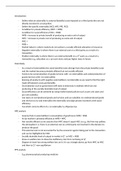International Finance
Sarah P Part I = Behavioral Finance (25%)
VUB | 2021 – 2022 Part II = Derivatives (25%)
Part III = International Financial Management (50%)
, 1st Master International Business
Part I : Behavioral Finance
1. Behavioral Finance
People’s rationality is limited by the cognitive limitations of the mind, the time and information
available to make the decision.
Overconfidence of managers and investors
This the so-called “better-than-average-effect”: managers/investors think of themselves that they do
better than the average manager/investors.
• Overconfident people don’t only overestimate their own abilities but also ignore the
capacities of their rivals.
• Overconfidence is not always bad: overconfidence may allow organizations to function
better: An overconfident team member overestimates his marginal productivity what makes
him work harder. Consequently the other members will also work harder and the
organization will benefit from this.
Behavioral Finance = Financial decision making by normal people.
Normal human people:
• Make mistakes • Copy the behavior of others
• Are influenced by emotions • Can be irrational
Financial Decision Making
What makes it complex?
→ Uncertainty. Decisions involve future payoffs that are uncertain: Random variables.
→ Heterogeneity across individuals (skills, preferences, attitude,horizon, emotions,
perceptions,...).
→ Interaction between individuals, the economic system, technology (eg social media,
algorithmic trading,...).
You are the decision architect. By knowing about these biases, you can:
• Set rules to avoid them • Exploit the mistakes of others.
Nudging: encourage people to make decisions that are in their broad self-interest. Influence the
behavior and decision making of groups or individuals while still giving them freedom.
Page | 1
, 1st Master International Business
The course assumes you have a minimum level of financial literacy:
1. Time value of money
2. Computing returns
3. Diversification
1. Time Value of Money
Consumers and firms are willing to pay more than $1 in the future in exchange for $1 today. This
fundamental fact of financial markets, that receiving $1 today is better than receiving $1 in the
future, or, equivalently, that borrowers pay interest rates to lenders for the use of their funds, is
known as the time value of money.
Present and future Value Calculation:
Suppose R is the yearly interest rate
VT = future value at time period T
V0 = Present value
Formula changes in case of interest payments within the year due to compounding (receiving interest
on interest).
Compounding of interest (interest on interest):
Valuation
• Financial assets are bundles of future (expected) cashflows
• Assume n holding periods.
• In each period t+j the investor expects to receive a cash flow
• When the required rate of return is r, then the price the investor is willing to pay is:
Page | 2
, 1st Master International Business
Which Required Rate of Return?
General Formula :
The required rate of return is higher if the risk free rate is higher (opportunity cost) and if the
cashflow is more risky (higher uncertainty about future cash flows).
Returns
• Suppose that your financial portfolio has an initial value of 100$, and that over the year this value
increased to 110$.
• How much return did you make?
Answer: The simple 1-period return is the relative increase in value over that period.
Future returns are random variables
• Future prices and hence future returns are stochastic variables
• Today’s investment influences the future return: needs to be optimal in terms of balancing:
Suppose that you need to decide to invest in a product for which the return depends on three
possible scenarios for the state of the economy: good, neutral and bad. Each state happens with a
certain probability and outcome:
Is this an attractive investment when the risk free rate of return is 0%?
Answer:
→ We need to evaluate the expected return and risk of the investment.
→ The expected return of discrete outcomes is the sum of these outcomes, weighted by their
probability of occurrence:
o Risk averse investors will prefer the “risk free rate of return”: higher expected return and
less (no) risk.
Note the asymmetry between neutral/good and bad.
Page | 3
Sarah P Part I = Behavioral Finance (25%)
VUB | 2021 – 2022 Part II = Derivatives (25%)
Part III = International Financial Management (50%)
, 1st Master International Business
Part I : Behavioral Finance
1. Behavioral Finance
People’s rationality is limited by the cognitive limitations of the mind, the time and information
available to make the decision.
Overconfidence of managers and investors
This the so-called “better-than-average-effect”: managers/investors think of themselves that they do
better than the average manager/investors.
• Overconfident people don’t only overestimate their own abilities but also ignore the
capacities of their rivals.
• Overconfidence is not always bad: overconfidence may allow organizations to function
better: An overconfident team member overestimates his marginal productivity what makes
him work harder. Consequently the other members will also work harder and the
organization will benefit from this.
Behavioral Finance = Financial decision making by normal people.
Normal human people:
• Make mistakes • Copy the behavior of others
• Are influenced by emotions • Can be irrational
Financial Decision Making
What makes it complex?
→ Uncertainty. Decisions involve future payoffs that are uncertain: Random variables.
→ Heterogeneity across individuals (skills, preferences, attitude,horizon, emotions,
perceptions,...).
→ Interaction between individuals, the economic system, technology (eg social media,
algorithmic trading,...).
You are the decision architect. By knowing about these biases, you can:
• Set rules to avoid them • Exploit the mistakes of others.
Nudging: encourage people to make decisions that are in their broad self-interest. Influence the
behavior and decision making of groups or individuals while still giving them freedom.
Page | 1
, 1st Master International Business
The course assumes you have a minimum level of financial literacy:
1. Time value of money
2. Computing returns
3. Diversification
1. Time Value of Money
Consumers and firms are willing to pay more than $1 in the future in exchange for $1 today. This
fundamental fact of financial markets, that receiving $1 today is better than receiving $1 in the
future, or, equivalently, that borrowers pay interest rates to lenders for the use of their funds, is
known as the time value of money.
Present and future Value Calculation:
Suppose R is the yearly interest rate
VT = future value at time period T
V0 = Present value
Formula changes in case of interest payments within the year due to compounding (receiving interest
on interest).
Compounding of interest (interest on interest):
Valuation
• Financial assets are bundles of future (expected) cashflows
• Assume n holding periods.
• In each period t+j the investor expects to receive a cash flow
• When the required rate of return is r, then the price the investor is willing to pay is:
Page | 2
, 1st Master International Business
Which Required Rate of Return?
General Formula :
The required rate of return is higher if the risk free rate is higher (opportunity cost) and if the
cashflow is more risky (higher uncertainty about future cash flows).
Returns
• Suppose that your financial portfolio has an initial value of 100$, and that over the year this value
increased to 110$.
• How much return did you make?
Answer: The simple 1-period return is the relative increase in value over that period.
Future returns are random variables
• Future prices and hence future returns are stochastic variables
• Today’s investment influences the future return: needs to be optimal in terms of balancing:
Suppose that you need to decide to invest in a product for which the return depends on three
possible scenarios for the state of the economy: good, neutral and bad. Each state happens with a
certain probability and outcome:
Is this an attractive investment when the risk free rate of return is 0%?
Answer:
→ We need to evaluate the expected return and risk of the investment.
→ The expected return of discrete outcomes is the sum of these outcomes, weighted by their
probability of occurrence:
o Risk averse investors will prefer the “risk free rate of return”: higher expected return and
less (no) risk.
Note the asymmetry between neutral/good and bad.
Page | 3


